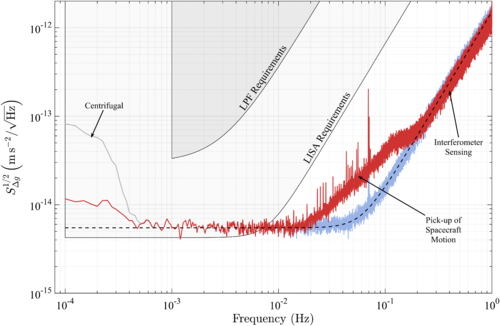Today’s another big day in the world of gravitational waves. ESA are expected to announce the results of their LISA Pathfinder mission in just over an hour. I’m going to attempt to write this blog post in at least two parts: one part (now) before the announcement, and one part during.
So why is this all important? Well, LISA Pathfinder is a technology demonstration mission. That means that it wasn’t capable of detecting gravitational waves. Instead it was assembled and launched to prove that it is possible to perform measurements at very high sensitivities in space: exactly what is needed to detect gravitational waves.
The ability to observe gravitational waves in space would be a major bonus for people who work on ground-based detectors, as it would give us advance warning of merging objects, because in space it’s possible to observe the inspiral of black holes at a much earlier stage in their evolution, so we might have weeks or even years to observe them cork-screwing their way towards each other, allowing us to predict when we’ll see their merger in a detector like LIGO or VIRGO.
LISA Pathfinder is particuarly important to our group (the Institute for Gravitational Research) at the University of Glasgow, because a large part of it was built here. The majority of the optical components were designed and assembled in the Kelvin Building at the University, and then shipped to Germany to be integrated with the rest of the spacecraft, bit of which were built across Europe, including at the AEI in Germany, and at the Universities of Birmingham and Southampton, in the UK.
There’s lots more to write, but thanks to my poor organisation it’s going to need to wait until after the announcement!
Well, the announcement happened, and it’s taken me a week to get around to writing the rest of this post. It’s probably worth taking a few sentences to explain why this was an important event, for some context.
LISA is a space mission which has been in the planning stages for decades, and which has suffered a number of set-backs along the way. Its mission will be to detect gravitational waves, but as you might have guessed, it will be searching for gravitational waves in a completely different range of frequencies from ground-based detectors like LIGO and VIRGO. At these frequencies we expect to be able to detect a different set of signals, ranging from the mergers of super-massive black holes, and possibly even remnant radiation from the big bang. This all deserves a blog post of its own, but there’s a nice description of the science on the mission’s website.
The need for a pathfinder mission was at least in part to prove that two rather different concepts could be made to work together: the final mission will require exquisite control of three spacecraft, with the need to keep them in the correct configuration at all times while they’re taking science data, millions of kilometres separated, while measuring the distance between them to microscopic (in fact picometre) precision. That hasn’t been done before. Which gets us to the results.

LISA Pathfinder: Noise Spectrum
The noise spectrum of LISA Pathfinder, measured 127 days after the spacecraft's launch.
The results from Pathfinder were almost certainly beyond anyone’s best expectations. To put the success of the mission in the words of Harry Ward, a member of the IGR at Glasgow, who leads the Glasgow effort for LISA,
I challenge anyone who walks into a lab, and turns on a new experiment, to have it not only work straight away, but to exceed your expectations the moment you turn it on.
The results of the Pathfinder are impressive, with the interferometer on-board not only working, having survived its launch into space, but working close to the sensitivity required by the specifications for the final mission, which were close to an order of magnitude more stringent than what Pathfinder was expected to acomplish.
The results have been published in Physical Review Letters.
The cover image for this post is LISA Pathfinder in low-Earth orbit (C) and is copyright ESA/ATG medialab. You can find a copy here